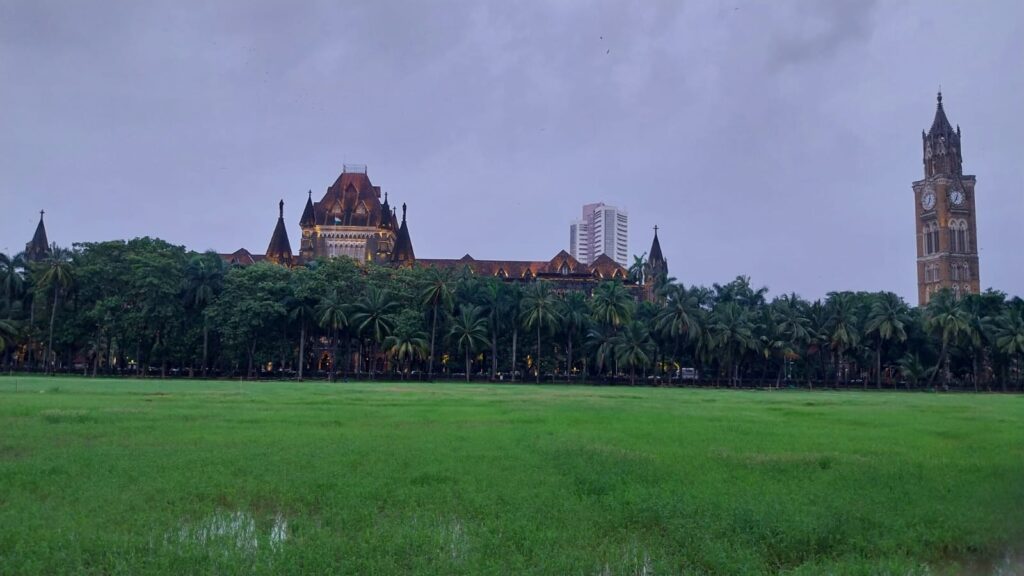The Bombay High Court was one of the three High Courts in India established at the Presidency Towns by Letters patent granted by Queen Victoria, bearing date June 26, 1862. It was inaugurated on August 14, 1862 under the High Courts Act, 1861.
The work on the present building of the High Court was commenced in April 1871 and completed in November 1878 and is situated between the University Building and the Public Work Secretariat and is 562 feet in length by 187 in breadth. It general height to the east is 90 feet, and the Central feature is 178 ½ feet in height. The building which is early English-Gothic was designed by Colonel J.A.Fuller, R.E. and was completed at a cost of Rs. 16,44,528 which was about Rs. 3000, less then the sanctioned estimate. The walls are of rubble and chunam faced with blue basalt roughly dressed and in shallow causes.
The true symbol of Justice, the stone statue of the Goddess of Justice, is on the battlement on the western front of the High Court building. She is represented with both eyes bandaged and holding the Sword of Justice in one hand and the Scales meticulously even in the other.
Gerald Aungier – Architect of the Judicial system
The main architect of the Judicial system during this period was Gerald Aungier. He was the Governor of Surat Factory. He had initiated for transformation of Bombay. He was honest man believed in true development, liberal ideas and believed in a impartial administration. He was dissatisfied with the judicial machinery. After instruction of East India Company, Aungier initiated for the appointment of officials to look after the law. He chose George Wilcox as the Judge and the First British Court of Justice was inaugurated in Bombay in 1672

History of Judicial System in Bombay
1661 – The Legal history of Bombay may be said to have begun in 1661, when it became a British possession.
1670 – the administration of Justice was in the hands of Justices who held their sittings in the Custom Houses of Bombay and Mahim.
1672 – the First British Court of Justice was inaugurated in Bombay.
1684 – The setting up of an Admiralty Court in 1684 under the Charter of 1683 opened the second phase in development of the Bombay Judiciary.
1726 – The evolution of the judicial institutions, “The Mayor’s Court” was established under direct authority of the King George I. The Mayor’s Court with its inherent defects of Principle and personal functioned for 70 years till 1798.
1753 – The East India Company obtained new Charter from King George II., reestablishing the Mayor’s Court.
1798 Recorder’s Court – In 1798 the Mayor’s Court was abolished and in its place was established the Recorder’s Court, as per the Charter of 1798. This brought positive change in judicial administration.
In 1823, an Act of Parliament authorised the Crown to establish a Supreme Court in place of the Recorder’s Court at Bombay by Royal Charter. The Court was formally inaugurated at Bombay on 8th May, 1824 and functioned till 1862.
1949 – The last appeal from India was disposed of by the Privy Council on December 15, 1949. Thus came to an end India’s 200 years’ old connection with the Privy Council on January 26, 1950, the Federal Court gave way to the Supreme Court of India under the new Constitution.
1956 – After the reorganisation of the States with effect from November 1, 1956, the territories of the Bombay State and with it the jurisdiction of the High Court were extensively extended. Benches of the High Court were established at Nagpur and Rajkot to deal with matters arising from Vidharbha and Saurashtra districts respectively.
2010 – The High Court organized several functions to mark the completion of 150 years of establishment of the High Court. A special postal cover was released by Milind Deora, the then Minister of State for Communications and Information Technology at the historical Central Court Hall of the High Court on 14 August 2012.
Contact of Bombay High Court
The Registrar General
Bombay High Court,
Fort, Mumbai -32.
How To Reach
Walking distance from Churchgate railway station.
Click here to visit website of Bombay High Court